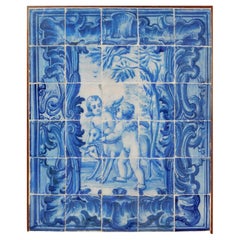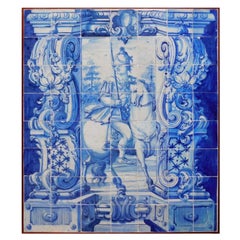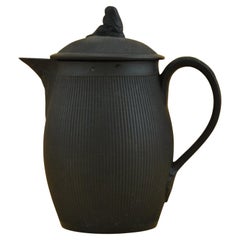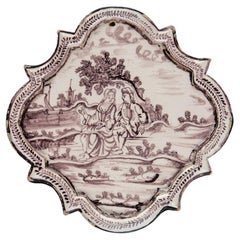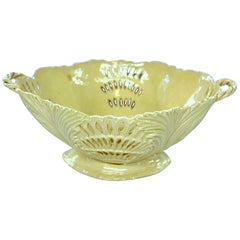European Ceramics
1
385
to
69
297
71
385
385
385
157
31
28
23
2
2
2
1
1
1
385
1,282
5,966
1,533
738
3,885
759
117
47
236
365
207
838
1,030
387
138
44
382
179
80
42
39
385
120
116
109
104
79
53
14
12
9
Period: 18th Century and Earlier
Place of Origin: European
18th Century Portuguese " Azulejos " Angels "
By Europa Antiques
Located in Madrid, ES
18th Century Portuguese " Angels "
Measures: 84 cm x 70 cm
30 Tiles.
Important note: This panel is with the tiles restored 18th century.
The panel is delivered as if it were a...
Category
18th Century Baroque Antique European Ceramics
Materials
Ceramic
18th Century Portuguese "Azulejos" Knight "Vase"
By Europa Antiques
Located in Madrid, ES
18th century Portuguese "Knight"
Measures: 98 cm x 112cm
56 tiles
Important note: This panel is with the tiles restored 18th century.
The panel is delivered as if it were a pa...
Category
18th Century Baroque Antique European Ceramics
Materials
Ceramic
Black Basalt Hot Milk Jug with Engine-Turned Decoration, Mayer, C1790
By Elijah Mayer Pottery
Located in Melbourne, Victoria
Baluster-shaped jug, with sparrow-beak spout and cover, for hot milk or hot water. The engine-turned decoration is particularly fine.
Marked.
Category
Late 18th Century Neoclassical Antique European Ceramics
Materials
Stoneware
Dutch ceramic Purple and White Plaque with Figures in a Landscape, Utrecht 1760
By Delft
Located in Verviers, BE
Purple and white plaque with figures in a landscape. Utrecht, circa 1760. Mark: Le J
Lozenge-shaped purple and white plaque with a conversing couple in a landscape. In the foreground a man and a women with a bare bosom sit on a river bank, behind them stands a tree leaning to the left. A church tower and some houses are depicted on the other bank and a boat sails on the water. The molded and raised rim is painted with a continuous branch of leaves, the back is glazed white. The woman with bare bosom shows that a pastoral scene is depicted. The man and woman are possibly shepherds, although their characteristic staff and sheep are lacking. Pastoral literature enjoyed considerable popularity in the seventeenth and eighteenth centuries and themes from it were frequently used for paintings, drawings and prints. The painter must have taken such a print as a model. The Le J signature is probably of the tile painter and has not yet been identified.
Besides the mass production of tiles, the tile factories in Utrecht in the eighteenth and the first half of the nineteenth centuries also manufactured other items on a small scale such as plaques, tobacco boxes, tea-stoves and shoes. Plaques form the largest part of this incidental production, and can clearly be distinguished stylistically and technically from Delft examples. Stylistically they are related more to tiles from Utrecht. The layered structure of the foreground with rocks and low shrubbery is derived from tiles with landscape, shepherd and biblical decors. The same also applies to the (leaning) tree, a typical Utrecht feature. The spiral cloud motifs are painted on Utrecht tiles as well. There are also important differences in production techniques. Delft plaques...
Category
Mid-18th Century Baroque Antique European Ceramics
Materials
Ceramic, Faience
Antique English Late 18th Century Yorkshire or Staffordshire Basket
Located in Charleston, SC
Rare antique English Yorkshire or Staffordshire creamware pierced basket with intricate reticulated body. Lovely color no damage or repairs.
Category
Late 18th Century Antique European Ceramics
Materials
Creamware
Pair of Sevres Style Swan Cream Cups
By Manufacture Nationale de Sèvres
Located in Copenhagen, K
A beautiful pair of Sevres Style cream cups, in the form of gilded Swans.
Category
18th Century and Earlier Empire Antique European Ceramics
Materials
Porcelain
Sitting Dog, Delft, circa 1740
By Delft
Located in Verviers, BE
The molded dog is sitting on a rectangular base and has its head raised and turned, and his snout opened. He wears a red-dotted collar. The dog is painted in blue, the stand in blue ...
Category
Mid-18th Century Baroque Antique European Ceramics
Materials
Ceramic, Faience
18th Century Portuguese "Azulejos" The Virgen"
By Europa Antiques
Located in Madrid, ES
18th century Portuguese " Angels "
Measures: 364 cm x 252 cm
439 tiles
Important note: This panel is with the tiles restored 18th century.
The panel is delivered as if it were...
Category
18th Century Baroque Antique European Ceramics
Materials
Ceramic
Assembled Pair of Wedgwood Cress or Strawberry Dishes, Late 18th C
Located in valatie, NY
An assembled pair of Wedgwood cress or strawberry dishes, Two Piece; Footed Pierced Dish with Stand. Late 18th c. This would have been used to serve watercress or strawberries after ...
Category
1780s Antique European Ceramics
Materials
Creamware
18th Century Staffordshire Blue and White Glazed Dog Whistle
Located in Stamford, CT
A rare and utterly charming English Staffordshire blue and white glazed ceramic dog whistle. Showing the pooch standing alert with tail up and ears pricked...
Category
Late 18th Century George III Antique European Ceramics
Materials
Ceramic
18th Century Portuguese "Azulejos" Spring"
By Europa Antiques
Located in Madrid, ES
18th century Portuguese "Spring "
Measures: 112 cm x 89 cm
48 tiles
Important note: This panel is with the tiles restored 18th century.
The panel is delivered as if it were a ...
Category
18th Century Baroque Antique European Ceramics
Materials
Ceramic
George 111rd Porcelain Coffee Can by New Hall Hamilton Flute, circa 1815
By New Hall
Located in Lincoln, Lincolnshire
This is a good, early hand-painted English coffee can, from the late George-III period, of the late 18th Century, circa 1795, which we attribute to ...
Category
Late 18th Century Georgian Antique European Ceramics
Materials
Porcelain
Dutch Delft, 1740-1760, Biblical ceramic Plaque with Moses and the Bronze Snake
By Delft
Located in Verviers, BE
Biblical plaque with Moses and the bronze snake in blue and white and yellow. Delft, 1740-1760.
The lozenge-shaped plaque has a molded and raised rim made up of scalloped ribbons alternating with shells. The plaque is painted with the biblical theme of Moses and the bronze snake. The painting is executed in blue, with only the bronze snake on the pole and three poisonous snakes on the ground accentuated in yellow. In the foreground the Numbers bible book reference ‘Num. 21 Vs 9’ is reserved in a small cartouche. The biblical story is at both sides bordered on either side by floral ornamentation and shells. The scalloped ribbons are painted with foliate scrolls. Two holes for suspension are pierced just below the upper shell. The reverse is glazed.
In the story of the Old Testament, Moses led the Israelites out of Egypt...
Category
Mid-18th Century Baroque Antique European Ceramics
Materials
Ceramic, Faience
18th Century Polychrome Delft Oil and Vinegar Stand
Located in Haddonfield, NJ
18th century polychrome Delft oil and vinegar stand in Imari flower decorations.
Category
Mid-18th Century Baroque Antique European Ceramics
Materials
Delft
18th Century Portuguese "Azulejos" Troubadour"
By Europa Antiques
Located in Madrid, ES
18th century Portuguese "Troubadour "
Measures: 140cm x 108 cm
80 tiles
Important note: This panel is with the tiles restored 18th century.
The panel is delivered as if it wer...
Category
18th Century Baroque Antique European Ceramics
Materials
Ceramic
Dutch Delft Blue and White ceramic Chinoiserie Plaque 1740-1760 Delftware
By Delft
Located in Verviers, BE
Blue and white chinoiserie plaque. Delft, 1740-1760.
This octagonal plaque has a thin, straight, upright rim with indented accolade-shaped corner...
Category
Mid-18th Century Baroque Antique European Ceramics
Materials
Ceramic, Faience
Dutch Delft Blue and White ceramic Chinoiserie Plaque. 1740-1760
By Delft
Located in Verviers, BE
Blue and white chinoiserie plaque. Delft, 1740-1760.
The oval blue and white plaque has a molded rim with four raised, oval cartouches. At the to...
Category
Mid-18th Century Baroque Antique European Ceramics
Materials
Ceramic, Faience
Rare Meissen Marcolini Tulip in a Tub circa 1780 Porcelain
By Meissen Porcelain
Located in London, GB
A Superb Meissen Marcolini tulip in a tub, Circa 1780.
Fine quality Meissen porcelain model of a flowerpot, modelled as cylindrical tub enhanced in gilt with 2 mythological masks on...
Category
1780s Antique European Ceramics
Materials
Porcelain
18th Century Portuguese " Azulejos " Cityside"
By Europa Antiques
Located in Madrid, ES
18th century Portuguese "Citywide "
Measures: 168cm x 126 cm
108 tiles
Important note: This panel is with the tiles restored 18th century.
The panel is delivered as if it were...
Category
18th Century Baroque Antique European Ceramics
Materials
Ceramic
18th Century Portuguese " Azulejos " Virgin Wedding "
By Europa Antiques
Located in Madrid, ES
18th century Portuguese " Virgin wedding "
Measures: 154cm x 140 cm
110 tiles
Important note: This panel is with the tiles restored 18th century.
The panel is delivered as if ...
Category
18th Century Baroque Antique European Ceramics
Materials
Ceramic
Pair of English Porcelain Mini Cabbage Leaf Jugs, circa 1785
Located in New York, NY
With mask spout the sides moulded with upright leaves and painted with insects, foliated capped handle.
Category
1780s Antique European Ceramics
Materials
Porcelain
Dry-Edged Figure of a Ewe, Derby Porcelain Works, circa 1752
By Derby
Located in Melbourne, Victoria
Derby was able to produce exceptional work, and these vases are a brilliant example of what they were capable of, when making for the top of the market. The body, the modeling, and t...
Category
Mid-18th Century Rococo Antique European Ceramics
Materials
Porcelain
18th Century Portuguese " Azulejos " Saint Antony"
By Europa Antiques
Located in Madrid, ES
18th Century Portuguese " Saint Antony "
Measures: 266 cm x 168 cm
Important note: This panel is with the tiles restored 18th century.
The panel i...
Category
18th Century Baroque Antique European Ceramics
Materials
Ceramic
Polychrome Imari Cooler, Delft, 1713-1735, Mark: Ar for Adriaan Van Rijsselbergh
By Delft
Located in Verviers, BE
Polychrome Imari cooler. Delft, 1713-1735
Mark: AR Painter: Adriaan van Rijsselbergh
This oval ribbed cooler stands on three pyramid-shaped feet and is painted in a six-coloure...
Category
Early 18th Century Baroque Antique European Ceramics
Materials
Ceramic, Faience
Maiolica Oval Tray, Felice Clerici Manufactory, Milan, Circa 1770-1780
By Felice Clerici
Located in Milano, IT
Small oval tray
Felice Clerici Manufactory 1745-1780
Milan, Circa 1770-1780
Maiolica polychrome.
Dimensions: 10.82 x 8.66 in (27.5 x 22 cm); weight 0.4...
Category
1770s Rococo Antique European Ceramics
Materials
Maiolica
Black Basalt Teapot with Enamel Decoration, Probably Spode C1800
By Josiah Spode
Located in Melbourne, Victoria
Globular teapot in black basalt, painted with matt white, red and ice blue. Judging by the shape and general appearance, probably by Spode, in imitation of Wedgwood designs of the pe...
Category
Late 18th Century Neoclassical Antique European Ceramics
Materials
Stoneware
18th Century Portuguese "Azulejos" Countryside"
By Europa Antiques
Located in Madrid, ES
18th century Portuguese "Troubadour"
Measures: 252cm x 86 cm
108 tiles
Important note: This panel is with the tiles restored 18th century.
The panel is delivered as if it were...
Category
18th Century Baroque Antique European Ceramics
Materials
Ceramic
18th Century Portuguese " Azulejos " Saint Antony"
By Europa Antiques
Located in Madrid, ES
18th Century Portuguese "Saint Antony"
Measures: 266 cm x 210 cm
Important note: This panel is with the tiles restored 18th century.
The panel is ...
Category
18th Century Baroque Antique European Ceramics
Materials
Ceramic
Blue and White Chinoiserie Wine Jug Delft, 1650-1670
By Dutch Originals
Located in Verviers, BE
Blue and white chinoiserie wine jug Delft, 1650-1670
The ovoid-shaped wine jug stands on a waisted foot and has a slightly conical neck with a spo...
Category
Mid-17th Century Baroque Antique European Ceramics
Materials
Ceramic, Faience
18th Century Portuguese "Azulejos" Lady "Vase"
By Europa Antiques
Located in Madrid, ES
18th century Portuguese "Lady "
Measures: 262 cm x 170 cm
228 tiles
Important note: This panel is with the tiles restored 18th century.
The panel is delivered as if it were a ...
Category
18th Century Baroque Antique European Ceramics
Materials
Ceramic
18th Century Portuguese "Azulejos" Panel "Vase"
By Europa Antiques
Located in Madrid, ES
18th century Portuguese "Vase"
Measures: 131cm x 131cm
110 tiles
Important note: This panel is with the tiles restored 18th century.
The panel is delivered as if it were a pai...
Category
18th Century Baroque Antique European Ceramics
Materials
Ceramic
18th Century Portuguese " Azulejos " Prayer"
By Europa Antiques
Located in Madrid, ES
18th century Portuguese "Prayer "
Measures: 182cm x 182 cm
108 tiles
Important note: This panel is with the tiles restored 18th century.
The panel is delivered as if it were a...
Category
18th Century Baroque Antique European Ceramics
Materials
Ceramic
French Porcelain Covered Ewer and Bowl, Sevres, circa 1765
Located in New York, NY
Chintz pattern painted with panels of three variant frizes colores, one with variant diaper cartouches entwined with gilt and berried laurel, the second with entwined rose vines rese...
Category
1760s Antique European Ceramics
Materials
Porcelain
Dutch Delft, ceramic Plaque with a Courteous Scene, circa 1760
By Delft
Located in Verviers, BE
The octagonal plaque is painted in blue with a courteous scene. A young man offers a flower to a young lady accompanied by her chaperon, against a background of trees and shrubbery. ...
Category
Mid-18th Century Rococo Antique European Ceramics
Materials
Ceramic, Faience
Pair Wedgwood Egyptian Revival Black Basalt Sphinxes Made 18th Century, England
By Wedgwood
Located in Katonah, NY
These stunning Wedgwood black basalt sphinxes are a true masterpiece of Wedgwood craftsmanship and artistry. These mythical creatures are a sight to behold with their majestic woman's head, mighty lion's body, and elegant wings.
Each sphinx sits atop a raised rectangular base, adorned with a geometric design of circles and fleur-de-lis.
Each sphinx features a 'lotus flower' nozzle to hold candles, adding a touch of whimsy and charm.
Made in the eighteenth century, circa 1785, these sphinxes showcase Wedgwood's exceptional attention to detail and dedication to quality. The underside of each sphinx is marked with an impressed "Wedgwood" signature in lowercase letters. With a height of 10.2", a depth of 7", and a width of 3.6", these sphinxes are truly imposing in size and presence. In excellent condition, this pair is a rare and highly coveted find for collectors of Wedgwood black basalt.
Reference: "The Dictionary of Wedgwood" R Reilly and G Savage pg 323.
Dimensions: 10.2" height x 7" deep x 3.6" wide
Condition: Excellent with tiny edge chips invisibly restored
Price: $6,600
Background of Wedgwood black basalt:
In the mid-18th century, Josiah Wedgwood created black stoneware, which he named "Black Basalt," as it resembled Egyptian basalt...
Category
Late 18th Century Egyptian Revival Antique European Ceramics
Materials
Stoneware
Two Pairs of Italian Maiolica Baskets, circa 1780
By Antonio Ferretti
Located in Milano, IT
Two pairs of maiolica baskets
Antonio Ferretti Manufacture
Lodi, circa 1770-1790
Maiolica polychrome decorated “a piccolo fuoco” (third fire).
Measures: A) Height 3.54 x 6.69 x 9.84 in (9 x 17 x 25 cm);
B) Height 3.93 x 7.48 x 11.02 in (10 x 19 x 28 cm).
Total weight 4.85 lb (2.200 kg)
State of conservation:
A) One of the smaller baskets has some areas of restoration, the other slight chipping from use;
B) One of the larger baskets is intact and the other shows a clearly glued break.
The mold with which the baskets were forged simulates a wicker weave.
The two larger works have high, vertical walls, with branch-shaped handles penetrating the weave. The painted decorations, small polychrome flowers applied only externally, highlight the points where the weaves intersect.
The decision to leave the center of the basket devoid of decoration is highly unusual, but given the size and complexity of the shape, as well as the quality of the enamel, it is possible to hypothesize that it represents a precise choice in manufacturing or for a particular client.
The two smaller baskets have small, twisted handles and, on the outside, reproduce more decisively the characteristic wicker weave, obtained through thin molded lines. The interior exhibits a rich, typical decoration of naturalistic flowers: a bunch centered around a main flower and secondary stems accompanied by small “semis”. The exterior of these works is also adorned with small little flowers where the weaves intersect.
The size and morphological characteristics of the baskets confirm their attribution to the Lodi factory of Antonio Ferretti between 1770 and 1790, during its most successful period; by this point his original reworking of the "Strasbourg" decoration, known as "old Lodi", had achieved great fame even outside Italy.
This decorative choice represented a strong point of the Lodi factory, which established itself thanks to the vivid nature of the colors made possible by the introduction of a new technique perfected by Paul Hannong in Strasbourg and which Antonio Ferretti introduced in Italy. This production process, called “piccolo fuoco” (third fire), allowed the use of a greater number of colors than in the past; in particular, the purple of Cassius, a red made from gold chloride, was introduced. Its use allowed for many more tones and shades, from pink to purple.
The Ferretti family had started their maiolica manufacturing business in Lodi in 1725.
The forefather Simpliciano had started the business by purchasing an ancient furnace in 1725 and, indeed, we have evidence of the full activity of the furnaces from April of the same year (Novasconi-Ferrari-Corvi, 1964, p. 26 n. 4). Simpliciano had started a production of excellence also thanks to the ownership of clay quarries in Stradella, not far from Pavia. The production was so successful that in 1726 a decree of the Turin Chamber came to prohibit the importation of foreign ceramics, especially from Lodi, to protect internal production (G. Lise, La ceramica a Lodi, Lodi 1981, p. 59).
In its initial stages, the manufacture produced maolicas painted with the “a gran fuoco” (double fire) technique, often in turquoise monochrome, with ornamentation derived from compositional modules in vogue in Rouen in France. This was also thanks to the collaboration of painters like Giorgio Giacinto Rossetti, who placed his name on the best specimens next to the initials of the factory.
In 1748 Simpliciano made his will (Gelmini, 1995, p. 30) appointing his son Giuseppe Antonio (known as Antonio) as universal heir. After 1750, when Simpliciano passed away, Antonio was directly involved in the maiolica factory, increasing its fortunes and achieving a reputation on a European level. Particularly important was the aforementioned introduction in 1760 of the innovative “a piccolo fuoco” (third fire) processing, which, expanding the ornamental repertoire with Saxon-inspired floral themes, could commercially compete with the German porcelains that had one of its most renowned offerings in the naturalistic Deutsche Blumen. Antonio Ferretti understood and promoted this technique and this decoration, proposing it in a fresher and more corrective version, less linked to botanical tables...
Category
1770s Neoclassical Antique European Ceramics
Materials
Maiolica
18th Century French Rouen Ceramic Platter
Located in Winter Park, FL
A large 18th century French Rouen white glazed cul noir earthenware platter with scalloped edge, hand-painted with blue decorative banded border and a fruit basket in the center. Rob...
Category
18th Century Antique European Ceramics
Materials
Ceramic
Late 18th Century Blue And White Glazed Faience Charger, circa 1770, Denmark
Located in Haddonfield, NJ
A large Danish (or Northern German) faience charger from circa 1780 in blue and white flower decor.
The decoration is inspired by, or actually exact copies of the contemporary Chine...
Category
Late 18th Century Rococo Antique European Ceramics
Materials
Faience
Pair of French Directoire Late 18th Century Lidded Apothecary Jars with Labels
By Deroche
Located in Atlanta, GA
A pair of French Directoire period ceramic lidded apothecary jars from the late 18th century, with hand-painted foliage motifs, labeled Tamarind and Ext. Cicutæ A:F, from the Deroche...
Category
Late 18th Century Directoire Antique European Ceramics
Materials
Ceramic
18th Century Portuguese " Azulejos " Saint Antony "
By Europa Antiques
Located in Madrid, ES
18th century Portuguese " Virgin wedding "
Measures: 196cm x 168 cm
168 tiles
Important note: This panel is with the tiles restored 18th century.
The panel is delivered as if ...
Category
18th Century Baroque Antique European Ceramics
Materials
Ceramic
Large Blue and White Dish with Flower Vase, Delft, 1665-1675
By Dutch Originals
Located in Verviers, BE
Blue and white dish with flower vase. Delft, 1665-1675
The blue and white dish has a wide, spreading rim and is painted in the centre with a vase ...
Category
Late 17th Century Baroque Antique European Ceramics
Materials
Ceramic, Delft, Faience
18th Century Caughley Spoon Tray Porcelain Fisherman Pattern, circa 1780
By Caughley Porcelain
Located in Lincoln, Lincolnshire
This is an excellent example of a porcelain Spoon Tray made by the Caughley factory, Shropshire, England.
The Spoon Tray is made of porcelain and is vert...
Category
Late 18th Century Chinoiserie Antique European Ceramics
Materials
Porcelain
Pair of Italian Maiolica Tureens, Ferretti Manufacture, Lodi Circa 1770 - 1780
By Antonio Ferretti
Located in Milano, IT
Pair of maiolica tureens
Antonio Ferretti Manufacture
Lodi, circa 1770-1780
Maiolica polychrome decorated “a piccolo fuoco” (third fire).
a – 8.66 x 11.02 x 7.48 in (22 x 28 x 19...
Category
1770s Rococo Antique European Ceramics
Materials
Maiolica
18th Century Italian Maiolica Centerpiece Bassano Venice, circa 1750
Located in Milano, IT
Maiolica centerpiece
Pasquale Antonibon factory
Nove di Bassano, Venice, 1740-1770.
Measures: 1.85 in x 19.21 in x 15.27 in
4.7 cm X 48.8 cm X 38.8 cm.
lb 5.29 (kg 2.4)
State of conservation: thin passing fêlure with covered chipping and a glued foot
The Antonibon were an important family of Venetian...
Category
1750s Baroque Antique European Ceramics
Materials
Maiolica
Early New Hall Porcelain Bowl Chinese Figures Lady with parasol Ptn. 20, Ca 1790
By New Hall
Located in Lincoln, Lincolnshire
This is a hard paste porcelain waste or slop bowl by New Hall in a hand painted Chinoiserie figure pattern number 20, dating to the late 18th century, Circa 1790.
The bowl is well...
Category
Late 18th Century Chinoiserie Antique European Ceramics
Materials
Porcelain
Black Basalt Tea Canister with Applied Decoration, Mayer, C1790
By Elijah Mayer Pottery
Located in Melbourne, Victoria
Cyclicrical tea canister in engine-turned black basalt, with raised decoration. Unmarked, but the quality and finial clinch the attribution.
Category
Late 18th Century Neoclassical Antique European Ceramics
Materials
Stoneware
Delft, Blue and White Beer Mug with Peacock in Garden, circa 1680-1700
By Dutch Originals
Located in Verviers, BE
Blue and white beer mug with peacock in garden. Delft, 1680-1700.
The pear-shaped beer mug with pewter lid stands on a short foot and has an ear-shaped handle that ends in a rat t...
Category
Late 17th Century Baroque Antique European Ceramics
Materials
Ceramic, Faience
Abigail Griffith’s Rare Lambeth Delft Plate-England, 18th Century
By Abigail Griffith
Located in West Palm Beach, FL
A rare 9" Lambeth Delft plate:
"An English Delftware tin-glazed charger attributed to the Abigail Griffith London Lambeth pothouse. Great decorative blue and white delftware- boldly ...
Category
Late 18th Century George III Antique European Ceramics
Materials
Pottery
John Rose Coalport TRIO Porcelain Gilded Royal Garter Pattern, Circa 1800
By Coalport Porcelain
Located in Lincoln, Lincolnshire
This is an early porcelain trio comprising a coffee can, tea cup and saucer, all in gilded patterns, which we attribute to Coalport, John Rose & Co., Shropshire, England, made at the...
Category
Late 18th Century George III Antique European Ceramics
Materials
Porcelain
Four 17th Century Delft Blue and White Wall Tiles on Frame Set 1, Netherlands
Located in Lincoln, Lincolnshire
These are Four Delft ceramic wall tiles mounted on a modern wood frame, all with a blue and white hand painted flower pattern, made in the Netherlands during the 17th century, circa ...
Category
Late 17th Century Dutch Colonial Antique European Ceramics
Materials
Wood, Earthenware
Italy Mid-18th Century Pair of Ceramic Carafes in White and Blue for Pharmacy
Located in Brescia, IT
In the past, this pair of very beautiful ceramics carafes, was utilized in a Pharmacy to contain erbs and spices infusions.
The carafes show all signs of the time, they remain a pai...
Category
Mid-18th Century Rustic Antique European Ceramics
Materials
Ceramic
18th Century Portuguese "Azulejo " Panel "Hunting Scene"
By Europa Antiques
Located in Madrid, ES
18th century Portuguese " Azulejos " Hunting Scene"
Measures: 100cm x 88cm
49 tiles
Important note: This panel is with the tiles restored 18th century.
The panel is delivered...
Category
18th Century Baroque Antique European Ceramics
Materials
Ceramic
17th Century Portuguese "Azulejos" Panel "Vase"
By Europa Antiques
Located in Madrid, ES
17th Century Portuguese " Vase "
Measures: 73cm x 87cm
30 tiles
Important note: This panel is with the tiles restored 17th century.
The panel is delivered as if it were a pai...
Category
17th Century Baroque Antique European Ceramics
Materials
Ceramic
Antique French Creamware Lions 18th Century
Located in Katonah, NY
We are thrilled to offer this exceptional pair of creamware lions, each elegantly resting on a tall base adorned with sumptuous swags of dark blue "curtains" with gleaming yellow tassels and trim.
Crafted in France, these figures are unparalleled and truly a masterpiece of 18th-century creamware.
They date back to the late 18th century, circa 1790. Each lion's head and mane is exquisitely painted with vibrant yellow and lined in striking midnight brown. Their mouths are painted in delicate pink, adding an extra touch of charm.
Not only are these lions a sight to behold, but they will also bring a touch of humor to your home. Their jovial expressions make it impossible not to laugh along with them.
Leisurely resting on cushions draped with rich fabric and tassels, these friendly lions exude a very French attitude, seamlessly blending formality and friendliness.
Placed on a mantel, they would undoubtedly be the focal point of any room, commanding attention, and admiration from all who see them. These lions are genuinely a one-of-a-kind treasure that is not to be missed.
Dimensions: 6.5 inches tall x 6.75 inches long x 4.5 inches wide
Condition: Excellent
Price: $3200
Background of creamware
Creamware is the name given to a type of earthenware pottery initially made from white clays from Dorset and Devonshire combined with an amount of calcined flint.
Creamware was first produced in England sometime before 1740. Foremost of the pioneers of creamware in the Staffordshire Potteries was Thomas Whieldon. The young Josiah Wedgwood partnered with Thomas Whieldon from 1754-1759. When Wedgwood left to set up his own business, he immediately directed his efforts to developing creamware.
Around the same time, in the mid-18th century, French potters developed their creamware known in France as "Faience Fine...
Category
Late 18th Century Neoclassical Antique European Ceramics
Materials
Creamware
18th Century Spanish "Puente del Arzobispo" Madrid Hand Painted Earthenware Dish
Located in Marbella, ES
18th century Spanish "Puente del Arzopispo" Mardrid hand painted earthenware "salvilla" dish, a type of plate which stands on a pedestal and was used to hold and display smaller reci...
Category
18th Century Antique European Ceramics
Materials
Ceramic
Polychrome Chinoiserie Wine Jug, Delft, circa 1680
By Delft
Located in Verviers, BE
The polychrome wine jug has an ovoid body on a low spreading foot, a conical neck with spout and a handle with a scroll finish. The jug is painted in purple, yellow and green with a continuous chinoiserie landscape with three Chinese figures. A band with scroll ornaments and circles is applied to the shoulder just below the neck, the neck itself is decorated with two stylized flowers and scroll ornaments. The handle is decorated with stripes and scroll ornaments. Dimensions: height 19 cm / 7.48 in.
Multi-coloured chinoiserie landscapes on Delftware were only made for a short period of time, roughly between about 1680 and 1690. Most of the decors have been applied on dishes, lobed dishes, butter pots...
Category
Late 17th Century Baroque Antique European Ceramics
Materials
Ceramic
Pair of Early French Terracotta Figures of Pomona and a Girl, Signed Clodion
By Claude Michel Clodion
Located in New York, NY
A fantastic pair of 18th/19th century French terracotta figures of Pomona and a Girl Carrying Fruit in her Skirt, Signed Clodion. These excep...
Category
1790s Rococo Antique European Ceramics
Materials
Terracotta
Ecuelle, or Soup Bowl, Wedgwood, C1790
By Wedgwood
Located in Melbourne, Victoria
Covered bowl, perhaps for soup, in black basalt with ‘Etruscan’ encaustic painting.
Category
Late 18th Century Neoclassical Antique European Ceramics
Materials
Stoneware
Recently Viewed
View AllMore Ways To Browse
Ironstone Water Lily
Large Canton Bowl
Wedgwood Majolica Strawberry
Waterlily Silver
Vintage Thanksgiving
Orlando Peter
Charger Modernist
R Silver Plate Italy
Pedestal Bowl Chinese
Bottega Gatti
Old Mason Ironstone
Delftware Bowl
Ironstone China Dragon
Vintage Ceramic Pheasants
Ceramic Sets Vietri
Jones Oyster Plate
Staffordshire Church
Flying Bird Ironstone
